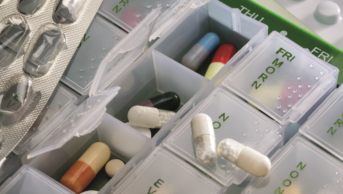
Deji Alli
I am the head of pharmacovigilance at Healthcare at Home and the Responsible Person for good distribution practice (known as ‘GDP’) for the UK, with oversight obligations for EU-based wholesale distribution.
Healthcare at Home is the UK’s largest in-home provider of complex high-cost medicines with full clinical support for more than 170,000 patients. The company’s services centre around patient medication, early hospital-supported discharge and wholesale activities; with long-standing contractual relationships with acute NHS trusts.
Although based in the UK, Healthcare at Home has operational hubs in Germany, Austria and Switzerland.
Pharmacovigilance plays a vital role once a medicine is licensed, as ongoing safety monitoring is essential throughout the drug’s life cycle. When a marketing authorisation has been granted, the medicine will have been tested in a relatively small cohort of patients. Homecare provides marketing authorisation holders (MAHs) with effective drug surveillance on their product, which is crucial to further optimising safe and effective use by the public.
A pharmacy background provides real-life knowledge of how products are used and developed, and an understanding of why it is important to manage safe storage and distribution. Experience of pharmacology informs knowledge of health system-related barriers to adverse event reporting, and this allows for appropriate interventions to be designed and risks to be managed.
Whether working in a hospital or community setting, or with global pharmaceutical companies, the patient always remains central to what I do
A typical day can vary considerably from one to the next. This demands a varied skillset and is one of the things that makes the role so enjoyable. Activities include general management of the operational performance of the pharmacovigilance function, but may also involve reviewing third-party subcontracted activities or working with IT on the design and development of opportunities for automation of essential activities.
My primary role is to ensure that the business maintains regulatory compliance with the Medicines and Healthcare products Regulatory Agency, and in particular, for good pharmacovigilance practices and good distribution practices. I have used my natural tendency towards the scientific methodology to build focus in what I do in the commercial environment. Whether working in a hospital or community setting, or with global pharmaceutical companies, the patient always remains central to what I do.
08:00 — start
My day normally kicks off with a focus meeting of the pharmacovigilance team. This allows senior team leaders to discuss commitments, share opinions and provide feedback on several topics. Standard items include case-processing workload, capacity planning, regulatory updates and any expected impacts from the implementation of new processes or contractual obligations.
The management of risk is central to what we do and any decisions we make. We need to understand the potential impact of medicines on patients at all times, as patient safety is paramount to what we do. In the next few weeks, we will be delivering one of the new adalimumab biosimilars as part of the biosimilar switch. This has potential to generate adverse events and/or product quality complaints, as patients will be administering the new biosimilar device for the first time. From a patient safety and pharmacovigilance perspective, I will need to monitor this carefully and consider the potential impact for an increase in reporting.
09:00
I have a teleconference with a pharmaceutical company. This is a regular call that provides assurance to the MAH that we are complying with relevant regulations and delivering agreed contractual outputs. Participants include global compliance managers, medical and commercial directors, and Qualified Persons responsible for pharmacovigilance. This particular call includes attendees from the EU, East Asia and the United States.
We discuss a range of agenda items, such as safety data reporting compliance; change management; updates on summaries of product characteristics; quality-control processes; business continuity plan testing results; and internal audits undertaken.
10:00
As part of the sales and operations planning for a proposed new service, I meet with the leadership team to focus on the main requirements to ensure good clinical practice. I’m there to sense check preparations underway by the project team, to ensure that requirements for pharmacovigilance and good distribution practice are captured, and that I’m on point for any actions required from me.
11:00
Healthcare at Home is subject to considerable external audit as we work with some large global pharmaceutical manufacturers. They have an obligation to ensure we comply with global and local regulatory standards, laws and contractual requirements. I join a Skype conference with personnel based at our national distribution centres. The purpose of the call is to make sure we are audit ready. Main topics include the quality-management system, adverse event training compliance, quality assurance activities, key performance indicators (KPIs) and validation of systems and equipment. Following the call, I have further queries to address before the audit over the coming weeks.
12:00
I have been working on an enhancement to the incident-reporting system with the software development team. After analysing the improvements required, I formally document them using a standard electronic template. This demand request consists of the problem statement, the benefits of the change taking place, the opportunities that can be realised and the associated costs of the implementation. The IT project-management office follows a methodology for development, which is aligned to regulatory validation requirements. This ensures we deliver what’s agreed and comply with recognisable standards.
I sign off the documentation and submit this to the advisory board, made up of stakeholders and subject matter experts. The board ensures solutions are safe, secure and meet the architectural principles for the IT environments. My submission includes proposals for user acceptance testing and requirements for final sign-off before going live.
13:00
During lunch I catch up with other members of the governance team, including clinical nurses and pharmacists. It is another opportunity where I can network with individuals from across the organisation outside of a meeting environment. I’m very conscious that soft skills are important to collaboration.
13:30
I review proposed safety data exchange agreements. These contractual documents are central to how Healthcare at Home operates. They codify what we’ve agreed to deliver and legally record the outsourced relationship between the MAH and us.
It is essential that I keep on top of our regulatory requirements and operational capabilities
It is essential that the agreements are right and my review consists of checking the good distribution practices and pharmacovigilance elements, ensuring they have sufficient detail and comply with the regulations applicable to the company, but also recognise local obligations relevant to the MAH. In this respect, some of our clients will have regulations or legal duties applicable to their country of origin, which may differ to the UK. The main standard items involve reviewing the reconciliation procedures for data exchange, timelines of transfer, periodic quality control checks and applicable local data protection laws.
These always require quick turnarounds, so I need to find the time to get a thorough review done. It is essential that I keep on top of our regulatory requirements and operational capabilities. Depending on the complexities of the service, some agreements will require further review until both parties are satisfied.
15:00
I have an adverse event training session planned with the customer patient service teams — a major touchpoint with and for patients. There is always a possibility during patient interactions that adverse events, adverse drug reactions or product complaints are mentioned. These sessions add to the mandatory company-wide adverse event training, but importantly, highlight the specifics associated with capturing all relevant information and immediately reporting incidents.
16:00
In readiness for Brexit, I am part of a working group which aims to ensure continuity of medicines supply and uninterrupted service delivery. We have been working with a wide range of stakeholders, regulatory bodies and our pharmaceutical industry clients to ensure we have the most robust plans in place. This group is chaired by our chief pharmacist, who I work especially close with on this topic, and on many other regulatory compliance matters.
17:00 — finish
I prepare for a visit that I have tomorrow morning at a hospital trust to discuss the monthly NHS KPI report on patient safety incidents and adverse events reported. In the afternoon, I have to finalise a presentation to support a bid and tender exercise for a new patient support programme. On this occasion, I will be discussing our pharmacovigilance excellence model and assurance arrangements.
How pharmacists can get a role in pharmacovigilance
- Be able to demonstrate an understanding of the NHS primary and secondary care models. Homecare experience is also desirable;
- Pharmaceutical industry experience will provide great exposure to drug safety regulations;
- Undertake an accredited training course that complies with the Responsible Person Gold Standard. This will demonstrate understanding of the importance of maintaining the quality and integrity of medicinal products throughout the supply chain;
- Although not essential, postgraduate qualification in either clinical pharmacy or an MSc in pharmacovigilance will be valuable for someone entering the homecare/pharmaceutical industry;
- Attend the Medicines and Healthcare products Regulatory Agency’s good distribution practice and good pharmacovigilance practice symposia. These events provide the latest information and guidance, and are a great platform for networking.


